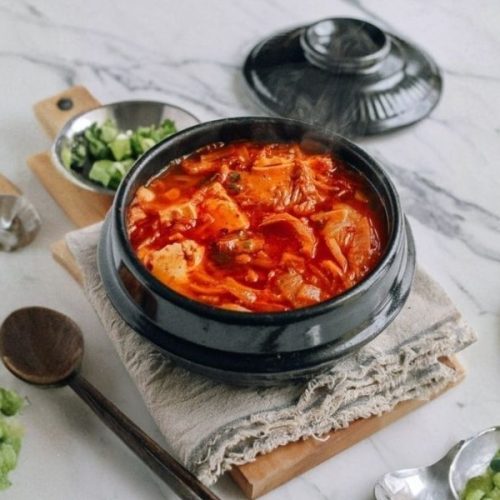
Korean Kimchi Stew
Kimchi Jigae is a spicy, savory Korean stew combining fermented kimchi, tender pork, and tofu simmered in a flavorful broth. It’s a quick, nutritious dish perfect for warming up any meal or prepping ahead for satisfying dinners.
Equipment
- 1 heavy-bottomed stockpot
- 1 sharp chef’s knife
- 1 silicone spatula
- Measuring Cups and Spoons
- 1 stone or ceramic serving bowl
Ingredients
- 1 tablespoon oil
- 1 medium onion thinly sliced
- 3 cloves garlic sliced
- 8 ounces pork belly or shoulder thinly sliced
- 1 pound kimchi with juices chopped
- 1 teaspoon salt
- 2 teaspoons sugar
- 1 tablespoon Korean chili flakes gochugaru
- 1 tablespoon gochujang Korean red pepper paste
- 3 cups chicken stock or substitute beef/fish stock
- 8 ounces firm tofu cut into 1/4-inch slices
- 1 teaspoon sesame oil
- 1 scallion chopped (for garnish)
Instructions
- Preparing the Aromatics and Pork: Begin by heating 1 tablespoon of oil in a large, heavy-bottomed stockpot over medium-high heat. Once the oil shimmers, add the thinly sliced onion and garlic cloves. Sauté these aromatics gently for about 2-3 minutes until they start to soften and release their fragrance. Then, add the thinly sliced pork belly or shoulder pieces to the pot. Cook the pork for approximately 5 minutes, stirring occasionally, until the meat is lightly browned and develops a rich, caramelized color. This step is crucial for building a deep, savory foundation for the stew.
- Incorporating Kimchi and Seasonings: Next, add the chopped kimchi along with its flavorful juices directly into the pot. Stir the mixture well and continue frying for about 2 minutes, allowing the kimchi to soften slightly and mingle with the pork and aromatics. Now, sprinkle in 1 teaspoon of salt and 2 teaspoons of sugar to balance the flavors. Follow with 1 tablespoon of Korean chili flakes (gochugaru) and 1 tablespoon of gochujang (Korean red pepper paste), stirring thoroughly to evenly coat the ingredients. These spices give the stew its signature fiery heat and complex taste.
- Adding Broth and Simmering: Pour 3 cups of chicken stock (or your preferred substitute like beef or fish stock) into the pot. Stir everything together to fully combine. Increase the heat until the mixture reaches a gentle boil, then reduce the heat to maintain a simmer. Cover the pot with a lid and let the stew cook undisturbed for 10 minutes. This simmering process helps tenderize the pork and allows the flavors to meld deeply, enriching the broth with the spicy, tangy essence of kimchi.
- Introducing Tofu for Creaminess: After the initial simmer, carefully remove the lid. Gently arrange the firm tofu slices over the surface of the stew, distributing them evenly. Replace the lid and continue to simmer for another 10 minutes. During this time, the tofu will absorb the spicy broth, becoming infused with flavor while adding a smooth, creamy texture that complements the robust ingredients.
- Final Seasoning and Garnish: Once the tofu has warmed through, uncover the pot for the last time. Drizzle 1 teaspoon of fragrant sesame oil into the stew and stir gently to incorporate this nutty finishing touch. Taste the stew and adjust the seasoning if necessary, adding a pinch more salt or sugar to balance heat and acidity according to your preference. Finally, sprinkle the chopped scallion over the top as a fresh, bright garnish. Serve the Kimchi Stew piping hot alongside steamed rice for a truly satisfying meal.
Notes
- Use well-fermented kimchi for the best depth of flavor; fresher kimchi will yield a milder stew.
- Thinly slicing the pork belly or shoulder ensures it cooks quickly and absorbs the stew’s flavors.
- Adjust the level of spice by moderating the amount of Korean chili flakes and gochujang.
- Firm tofu is preferred to keep its shape during simmering; avoid soft or silken tofu as it may disintegrate.
- Simmer the stew gently after adding broth to allow flavors to meld without toughening the pork.
- Stir in sesame oil only at the end to preserve its delicate aroma and nutty taste.